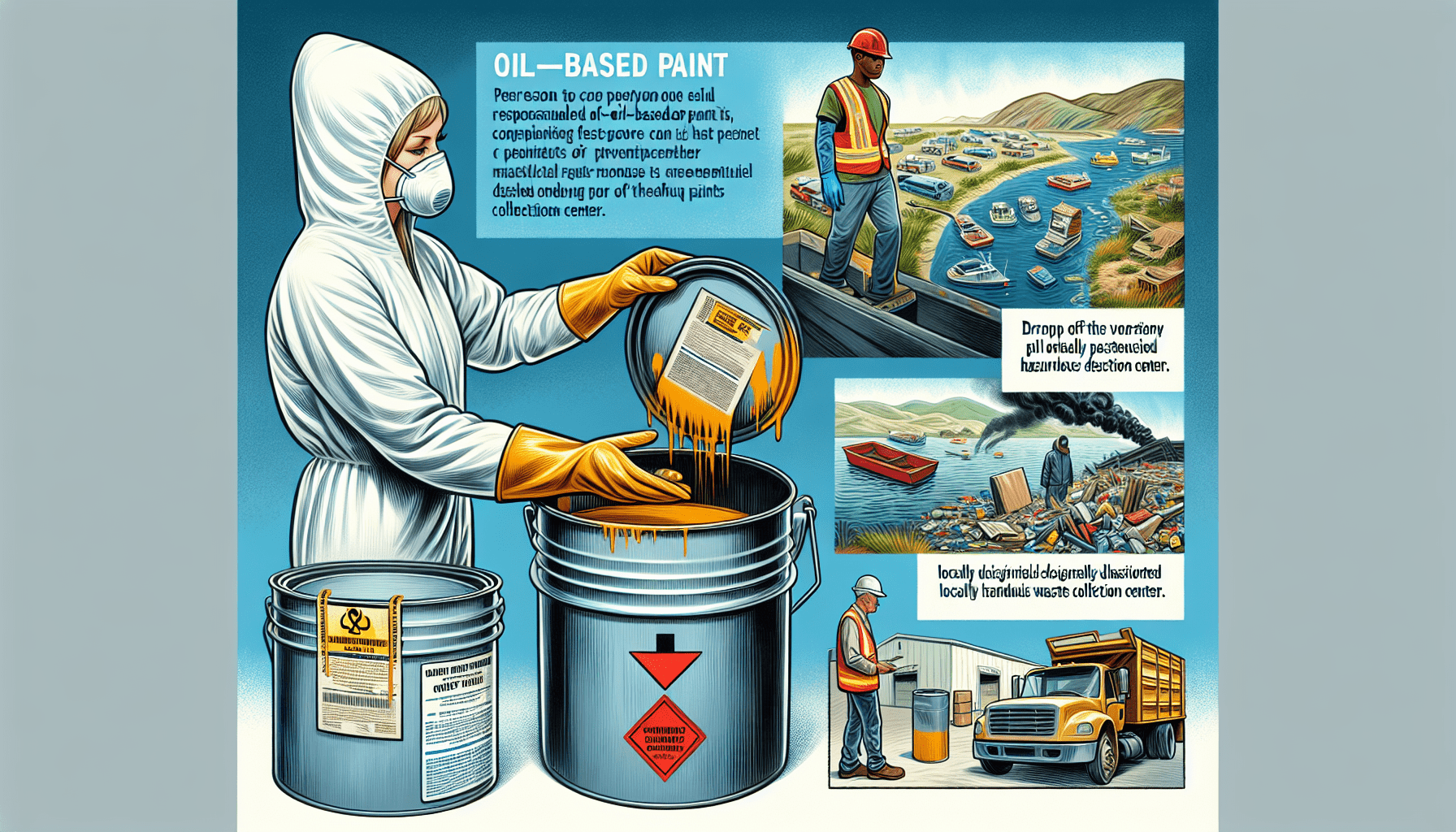In the realm of home improvement and interior design, a common question that surfaces is regarding the compatibility of oil-based paint with water-based primer. This article, “Can You Paint Oil Based Paint Over Water Based Primer”, precisely addresses this quandary, providing an in-depth analysis and evidence-based conclusions. It elaborates not only on whether you are technically able to merge these two different substances, but also the subsequent results you can expect and any potential drawbacks you must be mindful of. By the end of this informative discourse, you’ll possess the requisite knowledge to confidently embark on your painting projects.
Understanding Oil-Based Paint
Explanation of oil-based paint composition
Oil-based paint, as the name suggests, is made primarily of oil. It consists of pigments suspended in a medium of drying oil, typically linseed oil. The oil is what gives this type of paint its characteristic consistency and gloss. Oil-based paints contain natural and synthetic bristles that help give surfaces a smoother and more durable finish. The oil’s presence means oil-based paints are resistant to wear and tear, providing a tough outer layer on the surface where they are applied.
Benefits of using oil-based paint
Oil-based paint has numerous benefits which make it the go-to choice for a myriad of painting projects. First, it provides an exceptionally sleek and glossy finish that can’t be easily achieved with other types of paints. Second, oil-based paint is highly durable and resilient to wear and tear, thereby ensuring the longevity of your paint job. Additionally, it adheres to surfaces better, provides excellent coverage, and is less sensitive to temperature shifts. These traits make oil-based paints ideal for high-traffic areas, such as kitchens, hallways, bathrooms, and exteriors.
Understanding Water-Based Primer
Explanation of water-based primer composition
Water-based or latex primer, contrary to oil-based paint, is a paint product where water is the primary medium and solvent. Water-based primers contain resins (usually acrylic), a small quantity of solvent, and various additives. The primary function of these primers is to provide a stable base for topcoats, ensuring an even surface and enhancing paint adhesion. Furthermore, water-based primers are known for their quicker drying times compared to their oil-based counterparts.
Benefits of using water-based primer
Aside from relatively quick drying times, water-based primers demonstrate a host of other benefits. They are known for their low VOCs (volatile organic compounds), meaning they emit fewer harmful fumes, making them safer for indoor use and more environmentally friendly. Additionally, water-based primers are forgiving with regards to application mistakes, are effortless to clean up with water and soap, and do not yellow over time.

Compatibility of Oil-Based Paint and Water-Based Primer
Discussing the general incompatibility of oil-based paint and water-based primer
Contrary to popular belief, oil-based paint and water-based primer are not inherently compatible. As a general rule of thumb, oil and water don’t mix, a principle that applies in the world of paint as well. The hydrophobic (water-repelling) nature of oil-based paint creates a barrier that prevents it from combining effectively with water-based primer.
Reasons behind the incompatibility
The incompatibility boils down to the science of paint. Due to their distinct properties, water-based and oil-based products function differently. Oil-based paints can adhere well to surfaces because they seep into the substrate’s pores. On the other hand, water-based primers sit on top of the substrate rather than soaking into it, resulting in a poor bond between the primer and the oil paint.
Can You Paint Oil-Based Paint Over Water-Based Primer?
Exploring the possibility of using oil-based paint over water-based primer
Despite the conventional wisdom, it is possible to apply oil-based paint over a water-based primer. However, the success of the project hinges on several considerations you must take into account before proceeding, most notably the level of preparation involved prior to painting.
Factors to consider before doing so
One crucial factor to consider is priming. A high-quality, oil-based primer should be used as an intermediary bond layer between the water-based primer and oil-based paint. Another aspect to mull over is the type and condition of the surface you’re painting. If it’s moist, has high humidity, or is a challenging material like metal, the oil-based paint might not adhere well, even with the optimal primer.

Preparation and Testing
Importance of proper surface preparation before painting
Before you can even think about painting, surface preparation is paramount. This process involves cleaning the surface of any dust, dirt, grease, or lingering loose paint. If the surface isn’t adequately prepared, neither primer nor paint will adhere well, and you’ll be left with an unprofessional finish.
Conducting a compatibility test on a small area
Once you have suitably prepared your surface, it’s wise to conduct a compatibility test. Paint a bit of the oil-based paint over your water-based primer on an inconspicuous spot. Allow it to dry completely, then visually inspect and physically touch it to ensure the paint adheres well and doesn’t peel or flake off. This practice will give you an indicator of how well the oil-based paint will interact with the water-based primer.
Potential Issues and Solutions
Identifying potential issues when using oil-based paint over water-based primer
If you decide to proceed with applying an oil-based paint over water-based primer, you might encounter several potential issues. The paint may not adhere properly to the surface, leading to peeling, blistering, or cracking. Furthermore, without a correct bond, painted surfaces may lack long-term durability.
Providing solutions for each potential issue
To mitigate these potential issues, preparation remains key. Ensuring the surface is clean and primed correctly will help address these concerns right from the start. Moreover, using a bonding primer and adhering to recommended curing times can also ameliorate these problems.
Alternative Options
Considering alternative options to achieve desired results
Consider investigating other alternatives if you remain apprehensive about applying oil-based paint over water-based primer. Examples of these options include using a water-based paint over your water-based primer or using an oil-based primer with your oil-based paint.
Exploring other primer and paint combinations
Both options have their benefits and drawbacks. While the same type combinations reduce compatibility issues, they might not cater to your individual needs. If this is the case, research other combinations you could use or seek advice from a paint expert.
Expert Recommendations
Seeking advice from professionals and experts
While this article gathers comprehensive information on the topic, every painting project is unique. Therefore, consulting with paint professionals or experts can provide valuable insights and recommendations better tailored to your specific circumstances.
Following manufacturer guidelines
Another crucial step is following manufacturer guidelines for use and application. These guidelines are specifically designed to ensure maximum performance and durability of the products. Ignoring these recommendations can lead to substandard results or potential damage.
Tips and Best Practices
Offering tips and best practices for successful painting projects
For optimal results, always allow each coat of primer or paint to dry fully before applying the next layer. This practice is crucial in ensuring good adhesion and overall paint performance. Additionally, try to paint under optimal weather conditions. Extreme temperatures or high humidity can negatively impact paint application and the drying process.
Suggestions for achieving optimal results
Always invest in high-quality brushes and rollers. These tools directly influence the quality of your paint application, impacting the overall finish. Furthermore, never rush the painting job. Nice and steady gives you the best chance at a job well done.
Conclusion
Summarizing the key points discussed
In conclusion, using oil-based paint over water-based primer is possible but requires careful planning and meticulous execution. To achieve the best results, you need to factor in the prep work, quality of the materials used, compatibility testing, and the guidance of experts.
Final thoughts on using oil-based paint over water-based primer
Using oil-based paint over water-based primer may not be the most conventional approach, but it can yield satisfactory results if conducted correctly. It also adds to the flexibility of using varied products for your projects. In the end, remember it is crucial to observe paint rules, primarily concerning preparation and compatibility, whether you choose to use same-based or alternate-based products.



